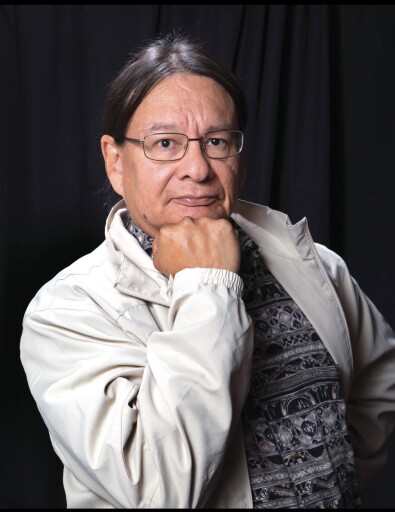

Gary Fife
September 21, 1950 — January 14, 2024
In Loving Memory of Gary Dale Fife
Gary Dale Fife, a legendary journalist and cherished soul, departed this world on January 14, 2024, at the age of 73 in Tulsa, Oklahoma. He was born on September 21, 1950, in Claremore, Oklahoma, to his parents, Robert James and Jennie Lee Fife.
Arrangements to honor Gary's life are entrusted to Schaudt's Glenpool-Bixby Funeral Service, located at 1329 East 151st St. Glenpool, OK 74033. Family and friends are invited to share kind words of comfort, special memories, and condolences online at www.schaudtfuneralservice.com.
A celebration of Gary's remarkable life will be held at 1:00 PM on Saturday, January 27, 2024, at the Muscogee Creek Nation Complex Mound Building in Okmulgee, Oklahoma.
Gary was a man of diverse passions and interests. He found solace in hunting, was an avid Star Wars fan, and held a deep fascination for anything related to World War II. His love for music, particularly old movies, and a penchant for alien films, Godzilla, and Frankenstein showcased his eclectic tastes.
Gary was a career veteran of journalism, with more than 50 years of experience in print, radio and television. He specialized in national Native and governmental affairs, spending 11 years in the nation's capital.
More than a hobby, journalism was Gary's lifeblood. He was a trailblazer in the field, reporting on almost every major event in Native American news since the 1970s. His tenure with Mvskoke Media witnessed his commitment to bringing stories of national significance to Indian Country. Gary was a true pioneer of Native Media.
Gary's roots were firmly planted in Tulsa, where he grew up on the north side of the tracks in the post-World War II era. His father worked for the airline, and the family later moved to the Pine and Harvard area. This shift marked Gary's entry into the Tulsa School system, where his early interest in journalism began to blossom.
He pursued higher education at Northeastern University in Tahlequah. The pivotal year of 1969 saw the occupation of Alcatraz by Native people, capturing the imagination of Indian youth nationwide.
He got on the school newspaper and realized that he really liked it, and this was his calling. By his third year of his curriculum at NSC, there came an opportunity to go to Washington DC and intern. Gary, already drawn to journalism, seized the opportunity to intern in Washington DC with an Indian magazine. This experience fueled his passion for presenting a balanced perspective in reporting, showcasing both sides of the story. This was eye opening going to a big city like that coming from Tulsa and Tahlequah areas. It was a time when major pieces of legislation started moving though congress. They were set up to look at every bill that came through congress to see if it had any implication for native people. At the time Native journalism was still in its infancy and just starting. Gary started writing articles showing both sides of the story and not just the Native side and found that very satisfying. At the time there were a lot of people that he knew going through college and had more of an interest in worldly affairs and not things that were just happening on the reservation. He realized that there was more to what AIM or the American Indian Movement was doing. There were people fighting on the legal front and the social conditions that were confronting his people. Going through this it is pretty much how Gary got his own philosophy of the day, making sure that his people got as much of a complete story as possible. This propelled him through 11 years of working in Washington DC into a communications job in Minneapolis, which was first person radio. This is where he discovered the power in broadcast media, and that a radio show can have such an impact on people. Radio is the perfect medium to translate information. From hearing how words are pronounced to the intensity of how words are used.
After that, Gary moved to Alaska with only a desk, a phone, and a phone book, for the prospect of founding the Indigenous-focused radio program, --the first Native weekday radio news service, 'National Native News.' At its peak, the program was carried on 181 public radio stations across the country. During Fife's tenure, the service won eight national awards in its first seven years. 'National Native News' began national carriage with National Public Radio and was later switched to American Public Radio.
He was just amazed at how he became part of Alaska and how it really grew into his soul, but his concerns for his family grew stronger. After some communications with his brother about their father Robert James Fife he was getting much older and had a stroke and was having a difficult time taking care of himself. He kicked around the idea with his wife about moving back to help him. This was a difficult decision because they felt like Alaska was a part of them. Gary spent 22 impactful years, becoming an integral part of the state. However, his concern for family, particularly his aging father, prompted a move back to Oklahoma with his wife, Ramona.
Now after moving back, he must build a new life with his wife in Oklahoma. At this point his father was around 86 and really having a hard time getting around and really needed some help. He found a job working for the Cherokee Nation for a while, before finding an opening with the Muscogee Creek Media and came in for an interview. Back in the radio program and talking to people and sharing information you really can't get elsewhere, he felt right back at home. A living encyclopedia of Native American history and broadcast, Gary had a unique way of addressing weighty topics, making them accessible to all. He contributed a column to the paper, providing an avenue for self-expression and commentary on societal matters.
During his career, Gary garnered numerous awards in national and state press competitions, three legislative citations from the State of Alaska and the Governor's Community Service Medal. In 1978, he was the first Native American recipient of a Ford Fellowship in Educational Journalism. Fife came back home to work for his tribal media outlet at Mvskoke Media, in 2011. In 2022, Fife was recognized with the Frank Greer Lifetime Achievement Award from the Oklahoma Society of Professional Journalism.
In September 2015, Gary was the first to stand and advocate publicly for the Muscogee Nation's first free press law during a Muscogee Nation National Council committee meeting where the bill was introduced. This speech was given with everyone above the department in the chain of command except the chief sitting behind Gary and a few other department employees who showed up to support it.
Throughout the Muscogee Nation's long free press fight for what would eventually become a constitutional amendment ratified by tribal citizens in September 2021, Gary stood as an example for and gave advice to those who continued to lead the cause. Before free press was even on the map, Fife risked asking tough questions of tribal officials with no legal protection for his job, serving as an example and setting the bar for other Mvskoke Media employees. In 2023 Gary was named as a "Living Legend," of the Muscogee (Creek) Nation. He reminded them that the citizens are the real bosses.
Gary is preceded in death by his parents, sister Melissa Fife, and brother Gene Cochran.
He is survived by his wife, Ramona, brother Victor and wife Susan, Sister-in-law Maureen M. Headbird- Brother-in-law Robert A. Headbird, Sister-in-law Mary R. Smith, Brother-in-law Charles Campbell, Sister-in-law Anne M. Smith, Brother-in-law Ernest F. Briggs, Sr. III, Brother-in-law Samuel K. Smith, Brother-in-law Paul R. Smith, along with cousins, nieces, nephews, and friends..
Gary Dale Fife will forever be remembered for his unwavering commitment to truth and storytelling, leaving an indelible mark on Native journalism. His legacy lives on in the hearts of those who were touched by his words and the stories he shared.
May Gary rest in eternal peace, surrounded by the echoes of the narratives he helped bring to light.
Service Schedule
Past Services
Celebration of Life
Saturday, January 27, 2024
1:00 - 3:00 pm (Central time)
Muscogee Creek Nation Complex Mound Building
Guestbook
Visits: 1376
This site is protected by reCAPTCHA and the
Google Privacy Policy and Terms of Service apply.
Service map data © OpenStreetMap contributors



